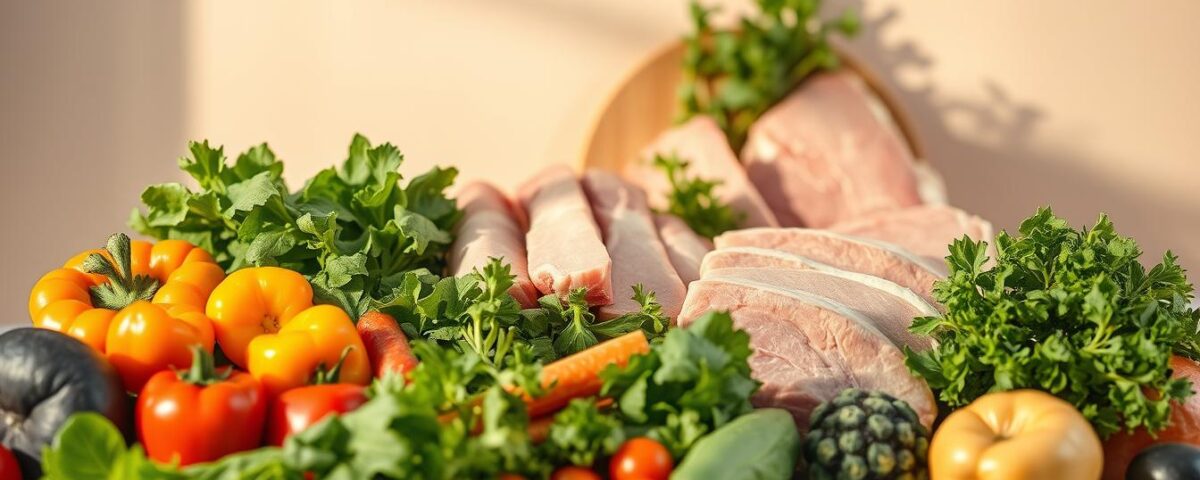
Biggest Mistakes People Make On The Atkins Diet And How To Avoid Them
February 19, 2025
The Carnivore Diet Exposed With Shocking Facts You Should Know
February 19, 2025When I first started exploring healthier eating habits, I felt torn. I loved the idea of eating more plant-based foods, but I wasn’t ready to give up my favorite chicken dishes or the occasional steak. That’s when I discovered a middle ground—a way to enjoy the best of both worlds. It wasn’t about strict rules but about finding what worked for me.
Did you know that research shows people who follow a semi-vegetarian lifestyle have a lower risk of heart disease and type 2 diabetes? A study with over 48,000 participants found that those who ate mostly plant-based foods but still included some meat had better health outcomes. This surprising fact made me realize that balance is key.
In this guide, I’ll share my journey of combining plant-based meals with occasional meat. You’ll find flexible meal ideas, tips for improving your overall health, and insights into how whole grains, legumes, and vegetables can play a role in your daily eating habits. Let’s dive in!
Key Takeaways
- A semi-vegetarian lifestyle can reduce the risk of heart disease and type 2 diabetes.
- Balancing plant-based foods with meat is achievable and beneficial.
- Whole grains, legumes, and vegetables are essential for nutritional balance.
- Flexible meal ideas can help you transition to a healthier eating pattern.
- Small changes in your diet can lead to significant health improvements.
Understanding the Flexitarian Diet
Finding a way to enjoy both plant-based meals and meat was a game-changer for me. It’s not about strict rules or cutting out entire food groups. Instead, it’s about creating a flexible eating pattern that works for your lifestyle. This approach is often called the flexitarian diet, and it’s gaining popularity for its simplicity and health benefits.
What is Flexitarianism?
Flexitarianism is a blend of the words “flexible” and “vegetarian.” It’s a way of eating that focuses on plant-based foods while allowing for occasional meat or animal products. Unlike a strict vegetarian or vegan diet, this approach doesn’t require you to give up your favorite dishes. Instead, it encourages you to make small, sustainable changes.
Key Principles Behind the Diet
The core idea is moderation. You’ll eat mostly fruits, vegetables, whole grains, and legumes, but you can still enjoy meat, fish, or dairy in smaller amounts. This balance helps you get the nutrients you need without feeling restricted. It’s also a great way to explore new recipes and ingredients.
One of the biggest misconceptions is that this approach is just a watered-down version of a vegetarian diet. In reality, it’s about finding what works for you. Whether you’re looking to improve your health, manage your weight, or simply eat more sustainably, this flexible approach can help you achieve your goals.
Exploring Flexitarian Diet Balance: Embracing Both Meat and Plant-Based Foods
Experimenting with plant-based and meat dishes has made my eating habits more versatile. I’ve learned that it’s not about choosing one over the other but finding ways to enjoy both. This approach has allowed me to explore new flavors while keeping my meals exciting and nutritious.
My Personal Approach to Flexibility
My strategy is simple: focus on variety. I start my day with a mix of whole grains and fruits, like oatmeal topped with berries. For lunch, I might have a salad packed with vegetables and a small portion of grilled chicken. Dinner often includes legumes or tofu alongside a lean cut of fish or beef.
Small adjustments, like swapping processed food for fresh ingredients, have made a big difference. For example, I’ll choose roasted sweet potatoes instead of fries or add lentils to soups for extra protein. These changes are easy to implement and have improved my overall health.
Daily Meal Swaps for Optimal Health
Here’s a glimpse into my daily routine. I’ve found that combining plant-based food with moderate meat consumption keeps me energized and satisfied. Below is a table of my favorite meal swaps:
| Meal | Original Choice | Healthier Swap |
|---|---|---|
| Breakfast | Bagel with cream cheese | Whole grain toast with avocado |
| Lunch | Cheeseburger | Grilled chicken salad |
| Dinner | Spaghetti with meatballs | Zucchini noodles with turkey meatballs |
Consistency is key. By making these swaps a regular part of my routine, I’ve managed to reduce risks like high cholesterol and enjoy the benefits of a well-rounded lifestyle. I encourage you to try similar adjustments and see how they work for you!
Health Benefits of a Flexitarian Lifestyle
Switching to a more plant-focused way of eating while still enjoying meat has transformed my health in unexpected ways. By prioritizing plant-based food and moderating my meat intake, I’ve noticed improvements in my energy levels, heart health, and overall well-being.
Positive Impacts on Heart Health and Weight
One of the most significant changes I’ve experienced is better heart health. Research shows that reducing animal product consumption and increasing vegetable and whole grain intake can lower the risk of heart disease. Personally, I’ve felt more energetic and less sluggish since making these adjustments.
Managing my weight has also become easier. By focusing on nutrient-dense foods like legumes, nuts, and seeds, I’ve naturally reduced my calorie intake without feeling deprived. Here’s a quick look at how this approach has benefited me:
| Aspect | Before | After |
|---|---|---|
| Energy Levels | Low, frequent fatigue | Consistent, high energy |
| Heart Health | High cholesterol | Improved cholesterol levels |
| Weight | Struggled to maintain | Easier to manage |
“Small changes in your eating habits can lead to big improvements in your health.”
Another benefit I’ve noticed is the variety in my meals. By combining plant-based food with occasional meat, I’ve discovered new flavors and recipes that keep my meals exciting. This approach has also helped me reduce my risk of chronic diseases while still enjoying the foods I love.
If you’re looking to improve your health, consider making small, sustainable changes. Start by adding more vegetables and whole grains to your meals and reducing processed foods. Over time, these adjustments can lead to significant benefits for your heart and weight.
Building a Balanced Flexitarian Meal Plan
Creating a meal plan that includes both plant-based and animal products has been a rewarding journey for me. It’s about finding the right mix of ingredients to keep meals exciting and nutritious. Here’s how I’ve built a plan that works for my lifestyle.
Incorporating Whole Grains, Legumes, and Vegetables
Whole grains, legumes, and vegetables form the foundation of my meals. They’re packed with nutrients and keep me feeling full longer. I love starting my day with oatmeal topped with fresh fruit or a smoothie made with spinach and almond milk.
For lunch, I often include quinoa or brown rice paired with roasted vegetables and a side of lentils. These ingredients are versatile and can be used in countless recipes. Adding variety ensures I never get bored.
Suggestions for Protein-Rich Meals
Protein is essential, and I’ve found ways to include both plant and animal sources. Tofu, chickpeas, and black beans are staples in my kitchen. They’re great for stir-fries, salads, and soups.
When I include animal products, I focus on lean options like chicken, turkey, or fish. A grilled salmon fillet with a side of steamed broccoli is one of my go-to dinners. Portion control is key to maintaining a healthy weight.
- Breakfast: Whole grain toast with avocado and a boiled egg.
- Lunch: Quinoa salad with roasted vegetables and chickpeas.
- Dinner: Grilled chicken with a side of sweet potatoes and green beans.
Meal prepping has been a game-changer for me. I dedicate a few hours each week to prepare ingredients, making it easier to stick to my plan. This approach reduces the risk of unhealthy choices and ensures I always have nutritious options on hand.
By focusing on variety and moderation, I’ve created a meal plan that’s both enjoyable and beneficial for my health. It’s a flexible approach that allows me to explore new flavors while staying on track with my goals.
Tips for Combining Meat with Plant-Based Ingredients
Mixing meat with plant-based ingredients has opened up a world of flavors and possibilities in my kitchen. It’s not just about nutrition—it’s about creating meals that are exciting and satisfying. Here are some of my favorite tips for blending these two worlds seamlessly.
One of my go-to techniques is cooking meat alongside vegetables and whole grains. For example, I’ll roast chicken with a medley of bell peppers, zucchini, and quinoa. This method preserves the nutritional value of each ingredient while enhancing the overall flavor.
Seasoning is key to making both meat and plant-based ingredients shine. I love using simple marinades like olive oil, garlic, and lemon juice. These add depth to the dish without overpowering the natural flavors. For a quick tip, pair iron-rich plant-based food like spinach with vitamin C sources like tomatoes to boost absorption.
Here are a few more strategies I’ve found helpful:
- Use lean cuts of meat like turkey or chicken to reduce fat while maintaining protein intake.
- Incorporate fruit into savory dishes—pineapple or mango can add a sweet contrast to grilled meats.
- Experiment with herbs and spices to create unique flavor profiles for both meat and plant-based components.
Another trick I’ve learned is to balance portions. I aim for a plate that’s 70% vegetables and 30% meat. This ratio ensures I’m getting the benefits of both without overdoing it. It’s also a great way to reduce the risk of overconsumption.
Finally, don’t be afraid to try new recipes. I’ve discovered so many delicious combinations by stepping out of my comfort zone. Whether it’s a stir-fry with tofu and beef or a salad with roasted chickpeas and salmon, the possibilities are endless.
By combining meat with plant-based ingredients, you can create meals that are not only nutritious but also full of flavor. Start small, experiment often, and enjoy the journey of discovering new favorites!
Navigating Challenges on My Flexitarian Path
When I decided to explore a more flexible way of eating, I faced several challenges that tested my commitment. One of the biggest hurdles was confronting common misconceptions about combining plant-based food with animal products. Many people assume that you must choose one over the other, but I’ve learned that balance is key.

Overcoming Dietary Misconceptions
Initially, I encountered skepticism from friends and family. They questioned whether this approach could provide enough protein or essential nutrients. I realized that many people are misinformed about the benefits of a flexible eating pattern compared to a strict vegetarian diet.
To address these doubts, I relied on trusted research and my own experiences. For example, I discovered that incorporating whole grain and vegetable combinations with lean meat can meet nutritional needs effectively. This approach not only supports health but also reduces the risk of deficiencies.
Here are some strategies that helped me navigate these challenges:
- Focus on variety to ensure a wide range of nutrients.
- Use lean cuts of meat to reduce fat intake while maintaining protein levels.
- Experiment with fruit and vegetable pairings to enhance flavor and nutrition.
By sharing my journey, I hope to inspire others to explore this flexible approach. It’s not about perfection but finding what works for you. With time and practice, you can enjoy the benefits of both plant-based food and animal products without feeling restricted.
Incorporating Variety for a Nutritious Lifestyle
Exploring a mix of plant-based and animal ingredients has brought excitement and variety to my meals. I’ve found that simple swaps and creative recipes can transform everyday dishes into something extraordinary. This approach keeps my eating habits fresh and ensures I’m getting a wide range of nutrients.
Simple Swaps and Creative Recipes
One of my favorite ways to add variety is by substituting common ingredients. For example, I’ll swap refined grains for whole grain options like quinoa or brown rice. These changes not only boost nutrition but also add new textures and flavors to my meals.
Mixing different animal product sources with fresh vegetables has been another game-changer. A stir-fry with tofu and beef or a salad with roasted chickpeas and salmon creates balanced flavors and textures. These combinations keep my meals exciting and nutritious.
Here are some tips I’ve found helpful:
- Use lean cuts of meat to reduce fat while maintaining protein levels.
- Incorporate fruit into savory dishes—pineapple or mango can add a sweet contrast to grilled meats.
- Experiment with herbs and spices to create unique flavor profiles for both meat and plant-based components.
Another strategy I’ve embraced is focusing on the journey of vegetables from farm to table. Understanding how they’re grown and handled has deepened my appreciation for their role in my meals. You can learn more about this fascinating process here.
By exploring a wide variety of foods and using creative recipes, I’ve overcome monotony in my eating habits. This approach has not only improved my health but also made cooking and eating more enjoyable. Start small, experiment often, and enjoy the journey of discovering new favorites!
Conclusion
My journey to a more flexible way of eating has been both rewarding and enlightening. By combining plant-based food with occasional meat, I’ve discovered a sustainable approach that works for my lifestyle. This balance has not only improved my health but also made meals more enjoyable and varied.
One of the biggest takeaways is the importance of variety. Incorporating vegetables, whole grains, and lean animal products ensures I get the nutrients I need without feeling restricted. Small changes, like swapping processed food for fresh ingredients, have made a significant difference in my energy levels and overall well-being.
I encourage you to experiment with your own meal plans. Start by adding more plant-based food and moderating your meat intake. Over time, you’ll likely notice positive changes in your health and how you feel every day.
Embrace flexibility and be open to trying new methods. This approach isn’t about strict rules but finding what works best for you. With a little creativity, you can enjoy the best of both worlds while supporting your long-term health goals.
FAQ
What is a flexitarian lifestyle?
A flexitarian lifestyle focuses on eating mostly plant-based foods while occasionally including meat and other animal products. It’s a flexible way to enjoy the benefits of vegetarian eating without completely giving up meat.
How do I start incorporating more plant-based meals?
I began by swapping one meat-based meal a day with plant-based alternatives like lentils, beans, or tofu. Gradually, I added more vegetables, whole grains, and nuts to my routine.
Can I still get enough protein without eating meat every day?
Absolutely! I rely on protein-rich foods like quinoa, chickpeas, nuts, and seeds. Even dairy and eggs can be great sources if you’re not strictly vegan.
What are some easy swaps for processed foods?
I replace processed snacks with fresh fruit, roasted nuts, or homemade veggie chips. For meals, I choose whole grains like brown rice instead of white rice or pasta.
How does this lifestyle benefit my health?
I’ve noticed improvements in my heart health and weight management. Eating more vegetables and less processed food has also boosted my energy levels.
Can I eat fish on a flexitarian plan?
Yes, fish is a great option! I include it occasionally for its omega-3 fatty acids, which are great for brain and heart health.
What’s the best way to balance meat and plant-based foods?
I aim for a 70-30 ratio—70% plant-based and 30% animal products. This helps me enjoy variety while still prioritizing whole, nutritious foods.
Are there any risks to this lifestyle?
As long as I eat a variety of foods, I haven’t faced any issues. It’s important to ensure I’m getting enough nutrients like iron and B12, which are common in meat.
How do I make meals more exciting?
I love experimenting with spices, herbs, and global cuisines. Adding ingredients like tahini, miso, or coconut milk can transform simple dishes into something special.
Can I still enjoy desserts on this plan?
Of course! I opt for healthier alternatives like dark chocolate, fruit-based treats, or desserts made with natural sweeteners like honey or maple syrup.



